CONQUERING MT. WHITNEY
Updated: Oct 24, 2023
Our attempt to summit the highest peak in the lower 48

I’ve let Sam lead the hiking planning. He’s AllTrails and Gaia savvy and can easily maneuver topographic maps to find the best trips. He knows my capabilities, sometimes even better than I know my own. My doubt kicks in, fear that I can’t handle a certain distance or elevation, recognizing that his fitness level is far superior. He’s a man who runs unofficial marathons in the Grand Canyon for fun.
We talked about Whitney for months after securing our winning tickets in the National Park Service’s lottery system. A mere 100 slots are allotted per day, limiting the trail useage and ultimately giving individuals one chance to summit per season with an official permit. The mountain boasts its size, named the highest peak in the contiguous U.S. at 14,505 feet, but I hadn’t realized what this actually meant - that at the end of May, it would still be blanketed in snow, melting more each day, and that the “99 switchbacks'' that hikers usually traverse up the steep sloped bowl below the summit ridge would be buried and untraceable.
Trip reports on trail apps had scared us so much so that Sam claimed there was “no shot” at summiting, that we would hike as far as we could to say that we had at the very least stepped foot onto this beast. To give us the best chance at making any headway past the “safer” portions of the trail, we invested in ice axes and microspikes during a trip to REI in LA, my cousin in tow, while I tried to hide my uncertainty and lack of knowledge about the endeavor ahead.
When Sam pointed to the helmets in the mountaineering section, I scoffed, asking him if it was really necessary. But the gear elevated the stakes to a higher level, and I slowly began to understand the kind of situation we would face. I had never used an ice axe before, let alone held one in my hand, warning him that I would need a lesson to ensure the purchase was even useful to me. It all seemed superfluous, imagining that by the time we reached an area where these things would be necessary, we’d turn around and head back down the mountain. Sam’s a gear head, and a safety fanatic, we surely only purchased these items “just in case…”
We planned a 4am start, beginning in darkness so the snow was still shrouded in a sheet of ice, allowing us to walk on top of its surface rather than sinking waist deep with each step. As soon as the sun rises, the thin outermost layer begins to melt, warming the snow beneath it to slush, a far more difficult terrain to navigate. The employees at a hiking store we stopped at below the mountain for ice axe leashes - something we had previously forgotten during that first gear trip, or rather, didn’t know we needed altogether - suggested we begin two hours earlier. A 2am departure allows even more time in the darkness before the sun awakens, before further melting the snow bridge on the trail they claimed had “a few more days before it would collapse.”
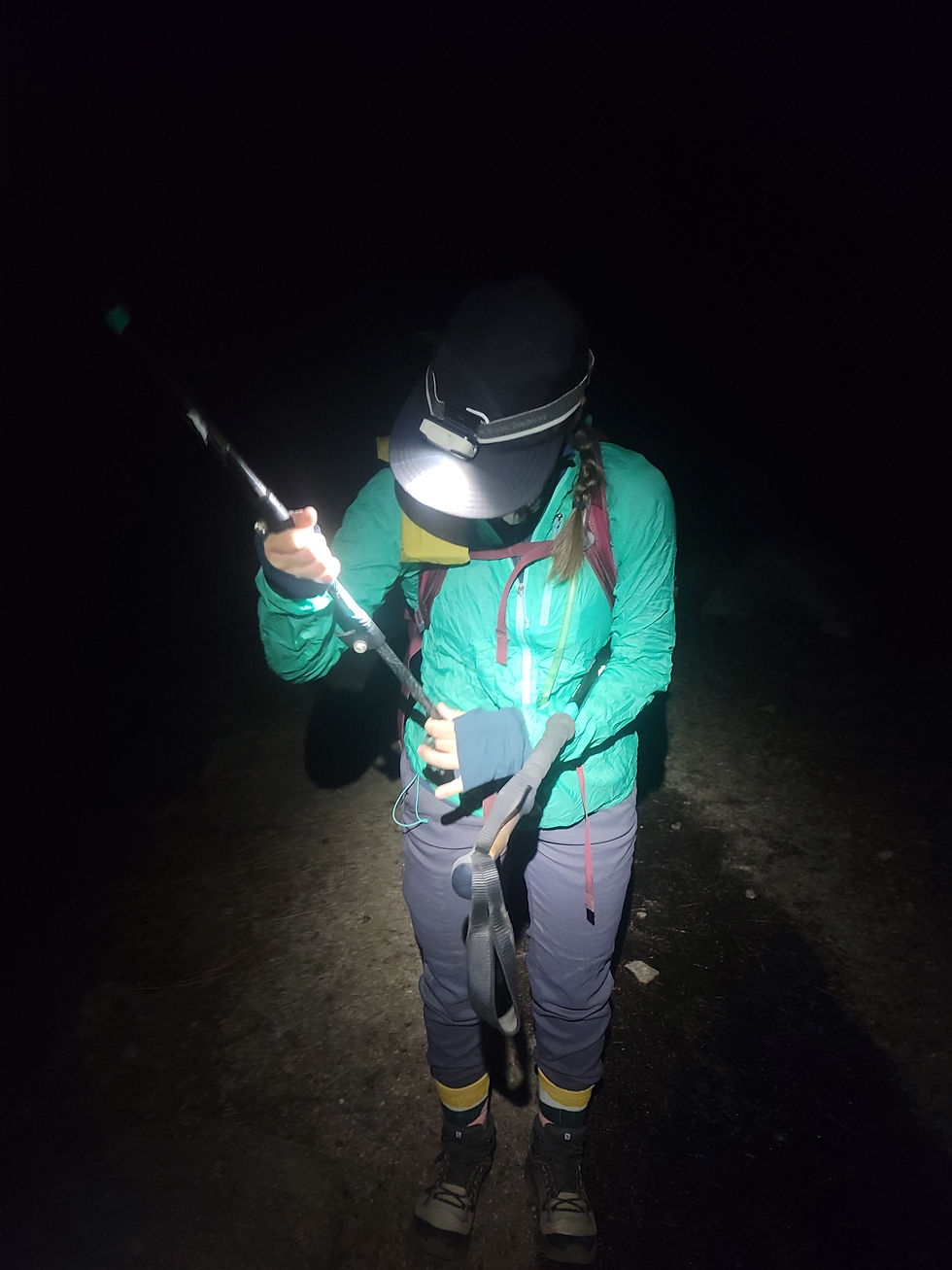
We stuffed our daypacks the night before: puffy jackets, windbreakers, extra socks, gloves, hats, trekking poles and snow baskets, 2.5 liters of water each, a water filter, far too much food to consume in one day, microspikes, new ice axes plus leashes, and our Garmin emergency satellite phone. We’d researched other suggested gear for a traverse in these conditions, but as our first exposure to mountaineering, and the tight budget of two jobless nomads, we’d decided to hold off on dishing out hundreds of dollars for items that may only be used once, as in, while hiking Mt. Whitney.
When we arrive at the trailhead at 3am, there’s a few cars in the parking lot. It’s pitch black but we can see head lamp lights in the distance of those already getting a head start before us. As I finish sipping my coffee and tying my shoes, Sam is pacing around me. He’s the type that throws the car in park and jumps onto the mountain. I’m the type who knows the sort of day that’s ahead of us, carefully executing each preparatory step before heading into the wilderness. I tighten the straps on my backpack, zip up my windbreaker, and chew one last bite of day old donut while we cross the parking lot to the trailhead.
Within the first mile, we see a stable orange light in the distance, hundreds and hundreds of feet away from the trail. It’s a much different and larger glow than the small white bobbing dots from the head-lamped hikers. Sam comments how fires are prohibited in this forest, just before we hear screaming, faintly echoing through the canyon, drowned out by the cascading waterfall that separates us. Every few screams, a whistle sounds, carrying even fainter than the voice. Hikers in front and behind us kept moving, not recognizing, or seemingly ignoring these signs of distress from across the way.
We stop to face the direction of the calling, our headlamps shining outward, stable instead of bobbing. Realizing that they’ve caught someone’s attention, the invisible human in the distance begins waving what appears to be a burning log, high above his head, back and forth, back and forth in a chorus of whistle and scream. If previously unsure whether a call for help, this new movement solidifies our decision to raise the alarm and call 911. After relaying the detailed story, the dispatcher advises us to continue on as before, hiking the trail that drove this human into a state of panic. It’s difficult to move away from their distress, looking back every few steps, whispering into the darkness that help is on the way. It’s less than an hour until we see red and blue lights in the distance, flashing between the trees.
We’d been handed all these warnings of the dangers of this mountain, and here, a deserted hiker signals for his life in the middle of the night, just as we begin. I receive it all, digest it, mull it over, but nothing deters me or raises the alarm inside my head about whether or not we should keep going. Perhaps I still hadn’t fully realized what we were about to face. Or maybe my general optimistic outlook overshadowed the doubt. Or maybe it’s my unwavering trust in Sam, the protection I always feel whenever he challenges me with something new, something even potentially dangerous.
So onward we climb…

…in the pitch dark. 3:30am dark, when headlamps light the direct path in front of you and nothing more. The tallest mountains I’ve ever seen surround me, but I can barely make out their shadowed outline in the faint light from the stars above. Someone has carved the way, making it easier to step up and over the snow, landing in the bootpack on the trail instead of this vast nothingness where every direction could be the right one. My eyes are cast down on the footprints in the landscape ahead, some days old, some fresh from Sam’s guiding steps. With this internal focus, the slopes don’t seem so steep and the pathways don’t seem so far. It’s a trick of the mind to keep pushing ahead because the next step is right there, just in front of you, each so achievable.
Around 4:30 am, as we climb just above the treeline. The sun begins to peek through the U-shaped valley between the mountains, illuminating what’s surrounded the entire climb, hidden in the shadows. The glowing stars fade and the amber light of the sun touches the top of the mountain, making its way down the cliff face, oppositional to its rising pathway. We’re engulfed by the surrounding peaks, the layers of snow sloping downward creating a curved effect in the basin, false protection from the surrounding elements. With the peaks looming above, we take out our ice axes. Sam demonstrates how to drive the axe into the snow if I were to slip and begin sliding down the mountain, picking up speed as my body descends. Just in case. In the short distance he’s trialed this maneuver, he’s scraped the side of his hand, a trail of red blood between the end of his pinky and the start of his wrist, a small sampling of the damage to occur if the fall were real.
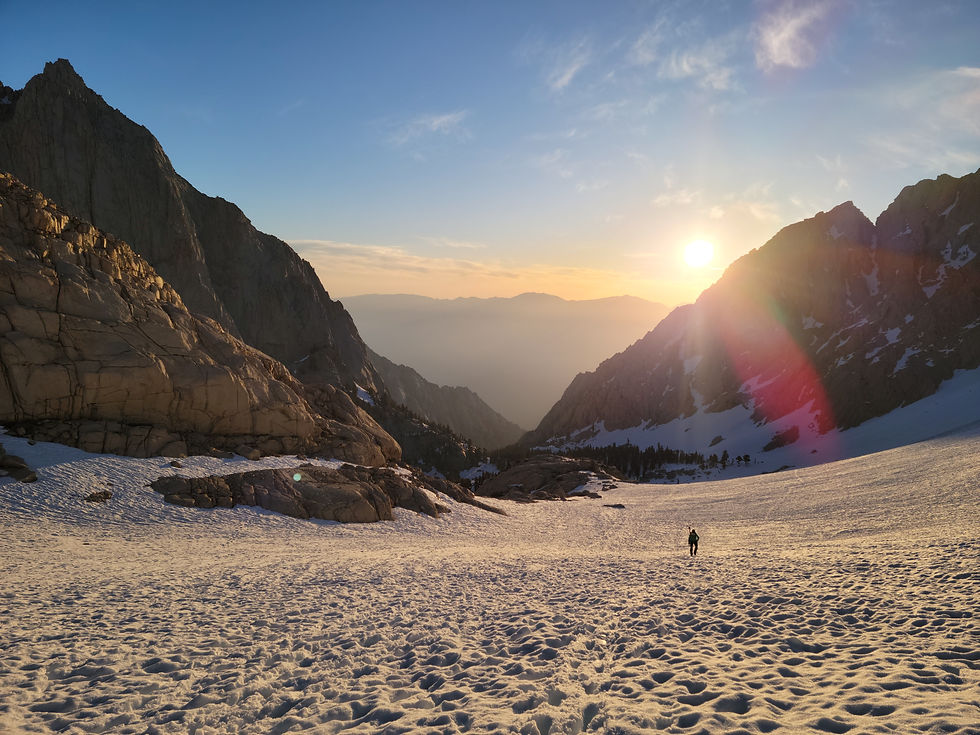
Trail camp was our originally planned destination, a location marked by a large moraine lake and exposed rocks. It sits just below the most drastic portion of the ascent. It’s here that many hikers stop to rest for the night, attempting the actual summit on day 2. We were granted a day hike in the lottery system, but were denied our request to camp, the area being overcrowded as is, an even fewer number of hikers allowed to stay the night. Those who do camp are granted the luxury of one more day of altitude acclimation, making their success rate of summiting much higher than the day hikers who attempt, if they even try to step foot on the mountain at all this time of year. 2023 saw record snowfall, the clouds dropping approximately 300% more snow accumulation than its typical year. Many will wait a few months until it has completely melted beneath the scorching sun. In late Summer, the conditions stabilize, offering solid ground underfoot, those 99 switchbacks exposed and safely traversed.
The tents tease us when we approach trail camp, hikers just climbing out of their shelters and stretching in the morning light when our eyes have been open since 2am. The sun hangs above us in the sky. It’s 6:30 am with just over 4 miles under our belt, our headway restricted when trudging through layers of packed snow.
“Eat some lunch and then head on up, you still have time to summit!” exclaimed a middle aged man, standing outside his tent with a mug of steaming coffee in his hand. “You’re the first ones to make it to trail camp this morning!”
This comment is puzzling considering the twinkling lights we witnessed above us at the start. There is a mountaineering route, a trail designed for those with more equipment than we carry ourselves. It requires steel crampons and mountaineering boots, harnesses and climbing gear, belaying skills and a team of at least two people, all aspects beyond our experience on mountains like this, beyond what our usual hiking trails require. We spoke to a few people at the fork in the trail who turned right to attempt this challenging mountaineering climb. But we’re uncertain what become of those hikers that turned left before us. A few headlamps veered off trail during some of those early miles, their trajectory hundreds of feet from where we stood. It’s easy to trust the bootpack of those that came before you, whether their knowledge of the trail was right or wrong. Perhaps this was the fate of all those bobbing lights — lost at the start and never found their way back, their attempt at summiting Whitney for that year lost with it.
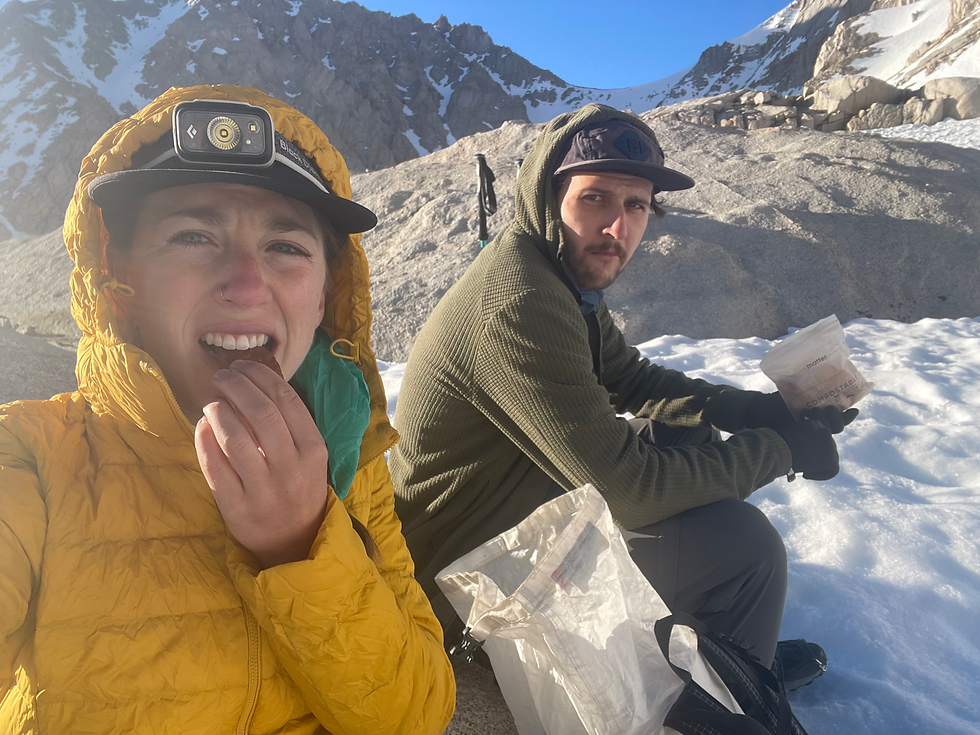
The night before, after my first ice axe lesson in the sandy desert below Whitney, we had briefly spoken about hiking to the peak, more of an aside than an actual plan. It hadn’t seemed at all possible when looking at the maps and reading the comments from others. But now, standing before her at such an early hour and with energy in our legs, we decide to try — to try to make it as far as we can, planning to check back in once we crest the top of the snow bowl. Snacking on protein bars and turkey jerky, our eyes trace five other hikers attempting the climb. They seem to make little progress as the time elapses, their bodies but small stick figures in the distance revealing the dramatic slope before us.
On the typical hiking trail, the slope is cut into switchbacks. The trail weaves from side to side to spread out any immense elevation gain into less severe mileage, avoiding a straight climb upward. But here, in the snow, it’s a free for all. There are multiple boot print pathways leading to the crest, mostly those with mountaineering boots who have cut small steps in the snow as they hike. The vertical angle of the climb feels like a ladder, the repetitive pattern of hand, hand, foot, foot. Hand, hand, foot, foot. With the ice axe in my right hand and trekking pole in my left, I pull myself up with each step, transferring weight into my upper body when my legs struggle with fatigue to lift the load.

Looking upwards, I can make out the platform of safety, the top of the bowl. Though I can’t yet see how the ground above is snowless, I’ve been told that once you’ve crested the white lip, one can regroup and stabilize on the rocky trail, sweet relief on steadier ground. Looking downwards, the angle of the slope is exposed and the impact and importance of the ice axe saving technique becomes quite clear. One slip from under my foot and I would begin sliding, picking up momentum as I fell further and further. I begin to see the appeal of the helmets Sam had pointed out while in REI, not only for a sliding accident but protection if chunks of rock or snow were to dislodge from above and plummet in our direction. With the sun beating down and the ice beginning to soften, cracks and pops echo within the basin as the freeze-thaw takes its toll on the surrounding cliff faces. I dig my feet in as I climb, compacting the snow under the weight of my toes, ensuring the spikes under my boots catch before moving upward.
The heart rate monitor on my watch reads 180BPM. The strain of the climb can account for a majority of that number, but my nerves certainly help elevate it. My breath is quick, disregarding any strategic inhales and exhales. I’m simply trying to breathe, but these sharp and shallow breaths hinder my body’s ability to feed oxygen to my straining muscles. I pause every few feet to reset and turn my upper body to relish the view, the tools in my hands anchored into the snow wall for stability. Below me, the lake grows smaller as we gain elevation. The angle of the wall tilts to a higher degree. It’s the climb that seems easiest on the mind, on the fear. The prospect of descending at such a sheer slope begins to intimidate me. There is but one way up and one way down, direct and steep. Each length of Earth I claim to the top, I must reverse in my steps, but the momentum upwards seems safer than the force of gravity driving downwards.
Two men to my right seem to have followed a more difficult path than the one Sam led me on. They’re kitted out in complete mountaineering gear from head to toe - boots, crampons, helmets, belays…. I see them begin to cut sideways, shuffling left and heading for the pathway I’m traversing. They admit their mistake aloud, yelling from their distant position, and I can hear regret in their voices. They must dig a new path in this horizontal direction, a more technical, more challenging task than simply following footprints carved by others.
The sight of climbers with more gear often makes me feel like an imposter, quite literally better equipped than myself. But a pair of fancy spikes on your shoes can only do so much. It’s moments like this that I’m reminded: gear helps, but muscle and brain are better tools. Body awareness, familiarity in weight distribution and negotiation of center of gravity offer far more in terms of security. Trust in the body, not sole reliance on the expensive extensions of it, are key in such technical maneuverings.
They tell me to go ahead before them, commenting on the speed I’ve displayed since they saw me approaching. I motion upwards, explaining that I’m only trying to catch up to him –- Sam sitting on the slope above me, patiently waiting, watching to make sure I’m following close behind.
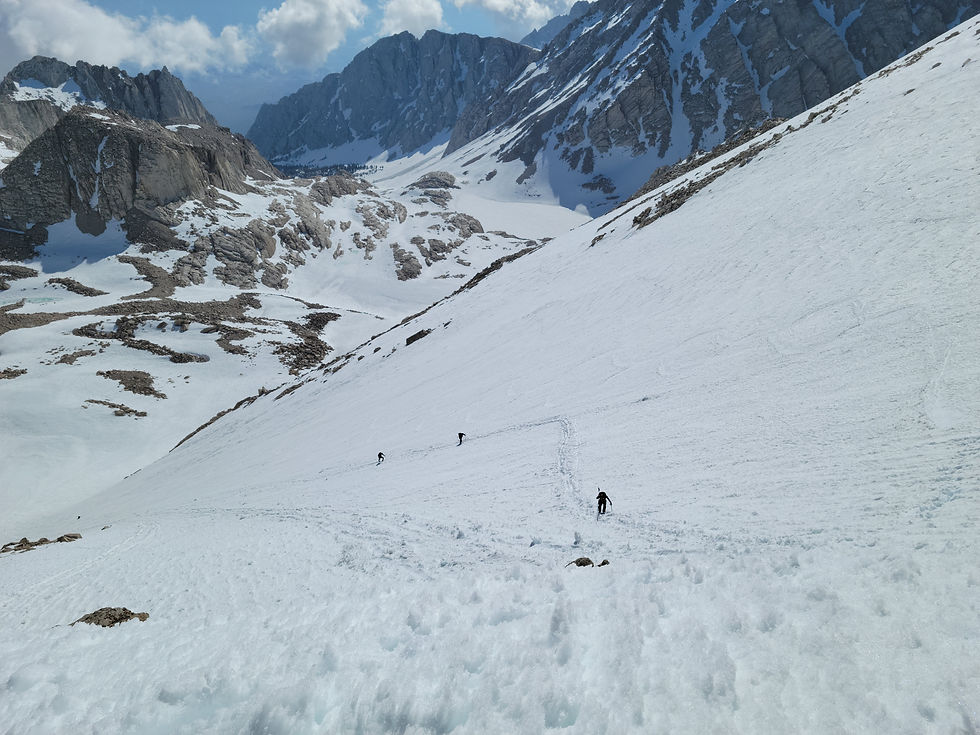
I often feel inferior to Sam on the trail. He’s a runner, the statistics on his watch reading superior results to my “below average” numbers. There’s a need to prove myself regardless, that even though on paper I show as the weaker candidate, I never want to say that I’m not capable to do what we’ve set out to do. All my life, I’ve always been the smallest, the youngest, the one that needs to work a bit harder to keep up with my older siblings and cousins. At this young age, I never let it intimidate me. Rather, it fueled my motivation to meet them where they were. I learned to prove myself despite these obstacles, despite a sense that something was beyond my ability. On this mountainside, I can feel these familiar childhood feelings. That little girl shows in the way I continue to take each step despite my adult inner dialogue questioning whether I have the strength. I can see it in my reaction to push harder to pass these men that I first perceived to be superior to me. I’m the only woman on these slopes, but gender seems to matter little as I leave these two struggling men behind me.
The final 50 feet of this intrepid climb offers an unfathomably steeper angle than before. Sam has disappeared above the crest at the top, and for a second, I’m alone. The steps are well carved, but any slight adjustment of my weight backwards and it seems I quite literally would fall off the mountainside. There is no room for error. It’s here that I question whether it’s all worth it. I know the most challenging part, descending this portion of the trail, still lies ahead and every step I take makes it all the more difficult. But this next milestone is right in front of me, and I’ve made it too far for these last few feet to make much of a difference. So I climb, with quaking quadriceps and butterflies in my belly.
Sam smiles when I reach him, thrusting my backpack to the ground. The sun is shining but the wind here is fierce. I pull on my windbreaker and slather sunscreen on my face, attempting to block these previously ignored elements. We deliberate – analyzing the power in our muscles, the time of day, the potential snowmelt, the adrenaline coursing through our veins – and decide to push on. Despite all the effort of the last few hours, we haven’t yet summited the peak of Mt. Whitney.
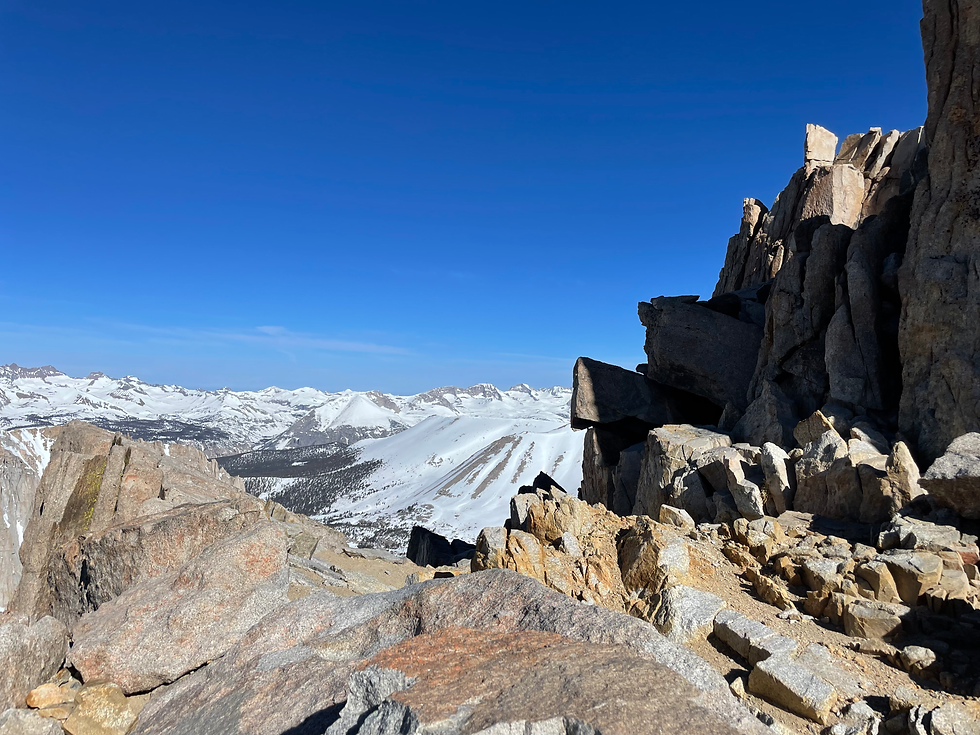
There’s 1.6 miles left to the peak. The remaining mileage seems familiar, like the carved rock hiking trails we’re used. It’s a relief to ditch the axes and crampons for a bit, tucking them into the packs on our backs. We imagine running this last leg to the summit, quickly “getting it over with” to claim success and turn around to face the real challenge ahead, the descent. But after a few steps uphill, I can’t seem to suck in enough air, my shoulders caving in from the effort. The next few steps prove harder than all the rest as the adrenaline fades from my body and the elements creep in. I have to consciously think about where to place my foot before I trust my leg to hold my weight. My body seems tethered to the ground, like I’m shackled into these rocks, but my head feels in the clouds, like there’s air in the spaces where thoughts should solidify.
What I anticipated would be the most leisurely segment of our journey proves to be the opposite. Altitude - its effects just beginning to make itself known. At this elevation, we stand 13,600 feet above sea level. 72 hours prior, we drove alongside the Pacific Coast Highway, just a few feet above the crashing waves. There is 40% less oxygen in the air at this height and my lungs quite literally can no longer supply my blood and muscles with what they need to perform.
I yell Sam’s name, unable to keep up with his pace. When I explain these sensations in my body, he confesses it’s hit him too, that I’m not suffering alone. If such shallow slopes have affected us in this way, it seems unsafe to continue on, what with the sun melting the snow as the minutes pass, our energy depleting with the lack of breathable air surrounding us. He’s ready to turn around, satisfied with just how far we’ve come. I hesitate, debating the glory of summiting the highest peak in the lower 48, payoff for all that we’ve endured so far. But my body is depleted. The looming fear of what consequences would lie ahead for pushing ourselves too far wins.
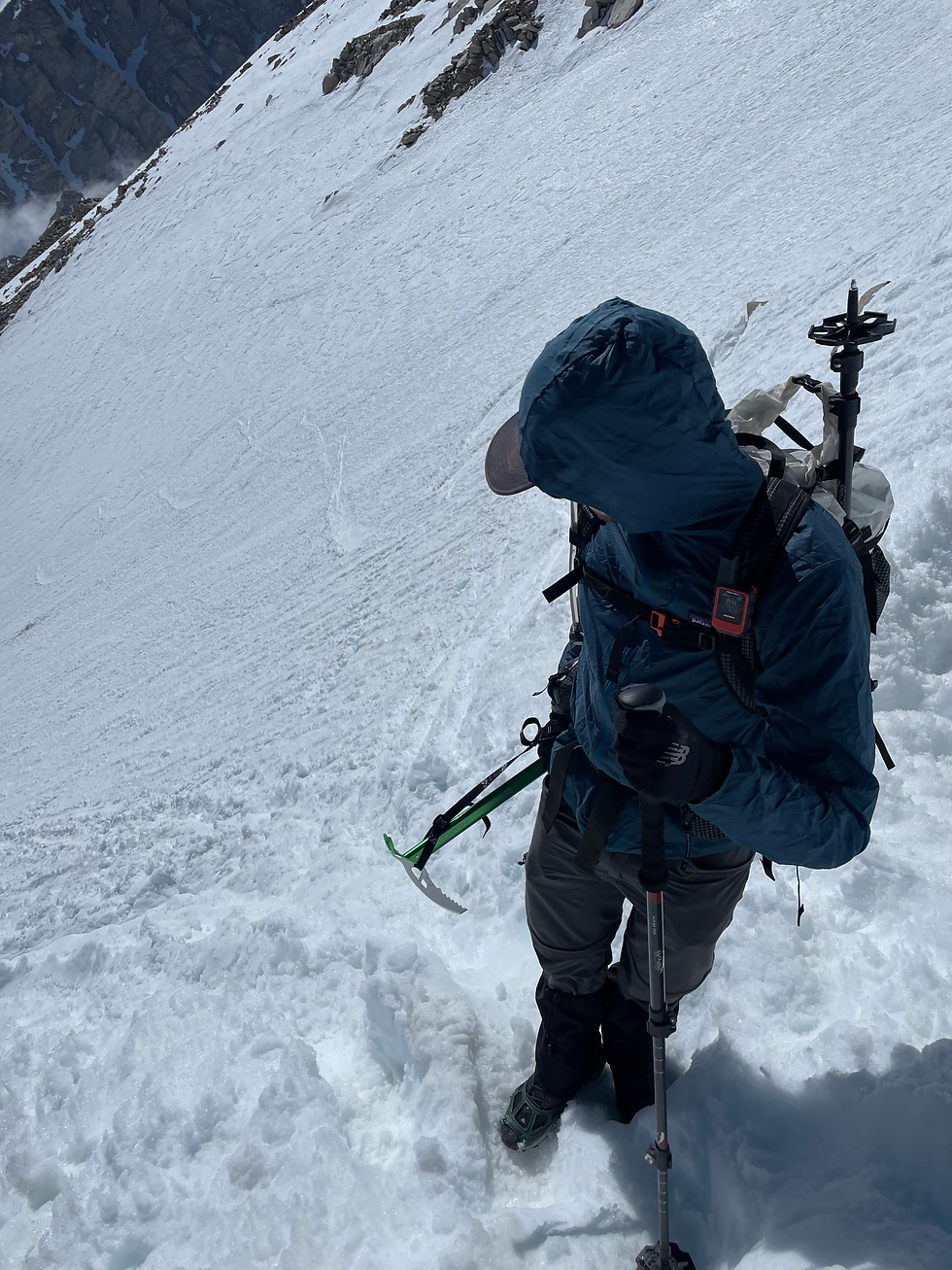
We step to the edge, pausing for a moment before beginning the descent. The expanse of the space and depth of the fall pounds in my brain. Sam goes first, instructing to climb down facing the mountain, keeping three points of contact to the wall at all times. The snow, this substance that can chip away and slide at the slightest kick, is hardly reassuring. “Use the steps carved by the others!” he yells, the steps we just climbed up so recently. Within a few moments, I can no longer hear his voice, the top of his head below the snow line, his words carrying out with the wind.
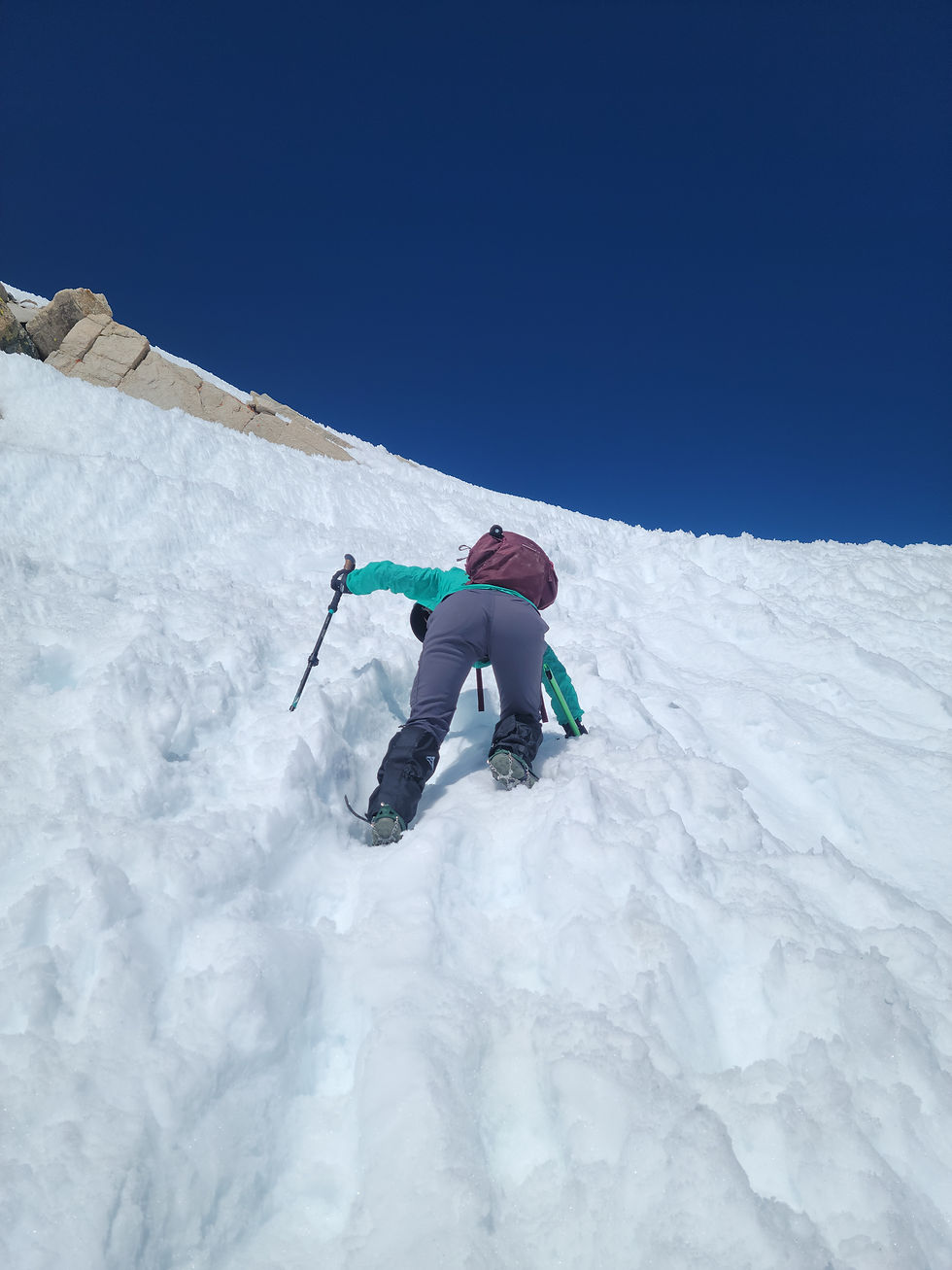
It’s hard for my brain to tell my body to move forwards. It’s the last step on solid ground, the last step facing forward before turning backwards, a direction and maneuver not often in practice for the human body. Like descending ladder rungs, I can’t see where I’m placing each foot. The tip of my boot probes the snowpack below, trusting in my toes to land in the nearest embedded footprint. But at 4ft 11in, these carvings are further than my legs can stretch to reach, and it takes a bit of courage to let them dangle, suspended in the air for just a second before letting go and willing my feet to fall into place. It’s a blind guess, unwavering trust in the body. But each step lands without mishap and we make it far enough down the mountain where turning around and facing the beast head on is safe. With trekking poles as anchors, our feet claw sideways as the clouds begin to overtake the valley. We’re far enough below the peak just in time for the impending afternoon storm.
It’s not quite a leisurely walk yet as our boots fall deep into the snow. That crisp icy sheet that once kept us afloat now caves into the weight of our bodies. We’re forced to lift each knee to waist height, lugging our feet out of the snow that’s engulfed each boot. Despite it all, there’s a lightness to my steps, almost a goofiness. We’re passed the most treacherous portion of the adventure and when you’re no longer afraid to fall, it’s easier to galavant down the mountain. Like springing deer, we hop from one foot to the other, picking up speed as we descend, little regard for where our feet land once out of the air. I fall, my leg occasionally lodged in the depth of snow topples me sideways. But we’re laughing and joyful in our clumsiness.
Beside every punctuated trail of footprints in the sloped sections of the snow lies a smoothly carved pathway about two feet wide. These “sled marks” continue for hundreds of feet until suddenly met with a small mountain of snow where the sloped angle dies off. Glissading, it’s called, where one slides on top of the snow on their butt assisted by an ice axe or crampons for control and self-arrest. It’s the point in the descent when legs can rest from the rigorous ascent and momentum steps in. With my ice axe as a brake trailing behind me, the mountainside becomes a playground. The tightly packed snow from the impact of multiple rear ends is slick, increasing my speed as I ride. To quote Sam, “Glissading is a controlled sliding but when given such a term, it sounds like a technical skill.” It’s fun as hell. We make it to our car in half the time it took us to reach the peak.
We never find out the story of the distressed hiker from earlier in the morning. There is no ranger station at the base of the mountain and Google search attempts come up blank. We text my cousin who took us shopping for ice axes in LA to tell him we’re off the mountain, safe and sound. He tells us his friend had urged him to call before we left to warn us of Whitney’s dangers, the weather creating conditions too precarious to climb at this time of year. I’m grateful he didn’t, grateful for his trust in us.
We’re just two kids from New York who hike mountains often. We’ve never stepped foot in such a threatening landscape, one well known to those who share this hobby on this coast of the country. The story seems epic, and it is, but I know we’ve just scratched the surface of this new world that has opened up to us.
As we reach the bottom of the trail in the early afternoon, stripping off wind breakers and long sleeves from the chilly morning above the clouds, a family in tennis shoes, shorts and tank tops begins to take their first steps onto the mountain, surely unprepared to cross the avalanche remains that sit a few hundred feet in. “Did you summit?” the Dad asks us. Our outfits and gear clearly set us apart from the leisurely day hikers who walk beside us. I pause. In technical terms, ours was a failed attempt. But such an answer to this question wouldn’t begin to justify what we’d just accomplished despite the terminology that locks us into a category. 906 feet from the summit is considered a conquering nonetheless. I let Sam reply.
“Next year...”
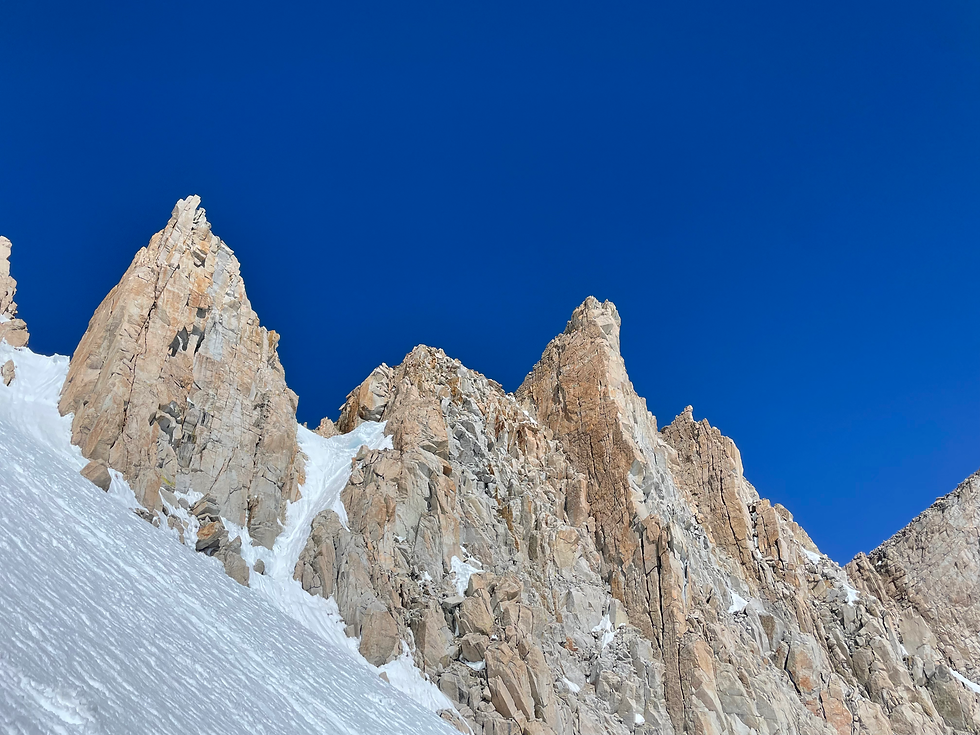

This was such a good write up I am sweating in a coffee shop after reading this Cassie. Great job, honestly, I am so happy to be the LA cousin, and not going to lie, hearing your recount of the climb at its worst reminded me of high altitude hiking and just looking shorter distances in front of me to ”make it” to that next moment. I’m so proud of you and Sam. Keep it up. Don’t forget there’s always next year to summit lol.
You’re the coolest! This is amazing, so happy for you guys.
Love it! You had me right there with you on the mountain!
CASSIE! this is just fantastic! It reads as a thriller, and I literally take every step with you. Gorgeous writing. Love you.